what to do with a lot of sand
Why the globe is running out of sand
(Paradigm credit:
Getty Images
)
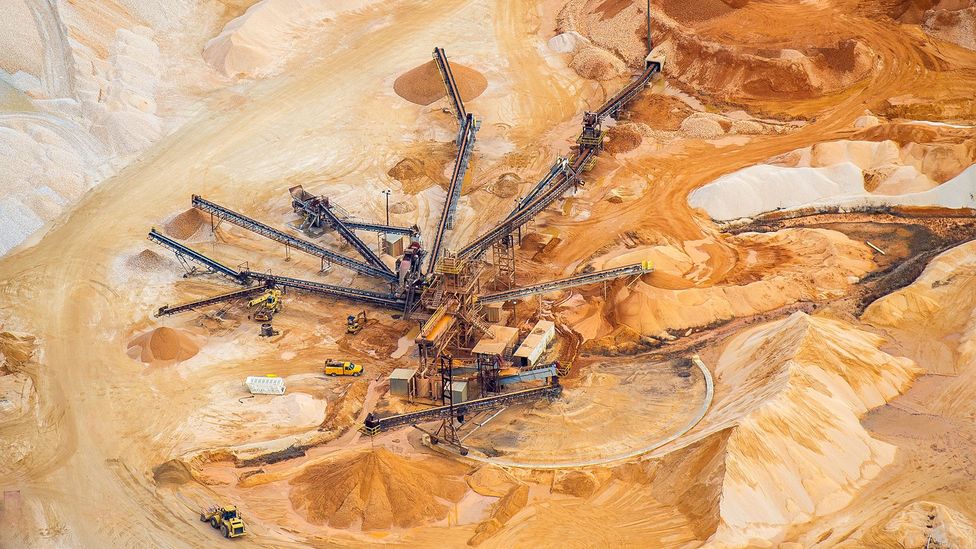
It may be little more than grains of weathered rock, and tin can be found in deserts and on beaches effectually the globe, but sand is as well the world's second near consumed natural resource.
A
A South African entrepreneur shot dead in September. Two Indian villagers killed in a gun battle in August. A Mexican environmental activist murdered in June.
Though separated by thousands of miles, these killings share an unlikely cause. They are some of the latest casualties in a growing moving ridge of violence sparked by the struggle for one of the 21st Century's most of import, but to the lowest degree appreciated, commodities: ordinary sand.
Trivial though it may seem, sand is a critical ingredient of our lives. It is the primary raw material that modern cities are made from. The concrete used to construct shopping malls, offices, and apartment blocks, along with the asphalt we use to build roads connecting them, are largely just sand and gravel glued together. The drinking glass in every window, windshield, and smart phone screen is made of melted-downwards sand. And even the silicon chips inside our phones and computers – forth with well-nigh every other piece of electronic equipment in your home – are fabricated from sand.
You might also like:
• The wall belongings back a desert
• How to survive an apocalyptic coma
• The "dead zones" hiding corking riches
And where is the problem with that, you might ask? Our planet is covered in it. Huge deserts from the Sahara to Arizona take billowing dunes of the stuff. Beaches on coastlines around the world are lined with sand. We tin fifty-fifty buy numberless of it at our local hardware shop for a fistful of pocket-size change.
But believe it or not, the world is facing a shortage of sand. How can nosotros possibly be running depression on a substance establish in virtually every land on globe and that seems essentially limitless?
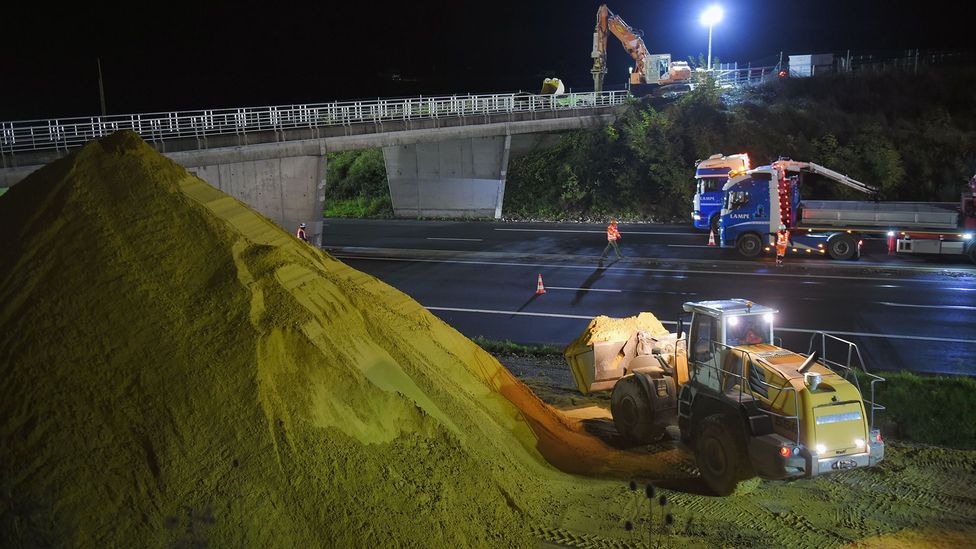
Creating the buildings and roads needed for the world'southward growing urban population requires vast volumes of sand (Credit: Getty Images)
Sand, however, is the most-consumed natural resource on the planet besides water. People utilize some 50 billion tonnes of "amass" – the industry term for sand and gravel, which tend to be institute together – every year. That's more than enough to blanket the entire Great britain.
The trouble lies in the blazon of sand nosotros are using. Desert sand is largely useless to us. The overwhelming bulk of the sand nosotros harvest goes to make physical, and for that purpose, desert sand grains are the wrong shape. Eroded by wind rather than water, they are too shine and rounded to lock together to form stable concrete.
The sand nosotros need is the more athwart stuff found in the beds, banks, and floodplains of rivers, besides equally in lakes and on the seashore. The demand for that fabric is so intense that effectually the world, riverbeds and beaches are being stripped bare, and farmlands and forests torn upwardly to get at the precious grains. And in a growing number of countries, criminal gangs have moved in to the trade, spawning an often lethal blackness market in sand.
"The issue of sand comes equally a surprise to many, but it shouldn't," says Pascal Peduzzi, a researcher with the Un Environment Programme. "Nosotros cannot excerpt 50 billion tonnes per year of any cloth without leading to massive impacts on the planet and thus on people's lives."
The main driver of this crisis is breakneck urbanisation. Every year there are more than and more people on the planet, with an ever growing number of them moving from the rural countryside into cities, specially in the developing earth. Across Asia, Africa, and Latin America, cities are expanding at a pace and on a scale far greater than any time in human history.
The number of people living in urban areas has more than quadrupled since 1950 to some 4.two billion today, and the United nations predicts some other 2.5 billion will join them in the next iii decades. That's the equivalent of adding viii cities the size of New York every unmarried twelvemonth.
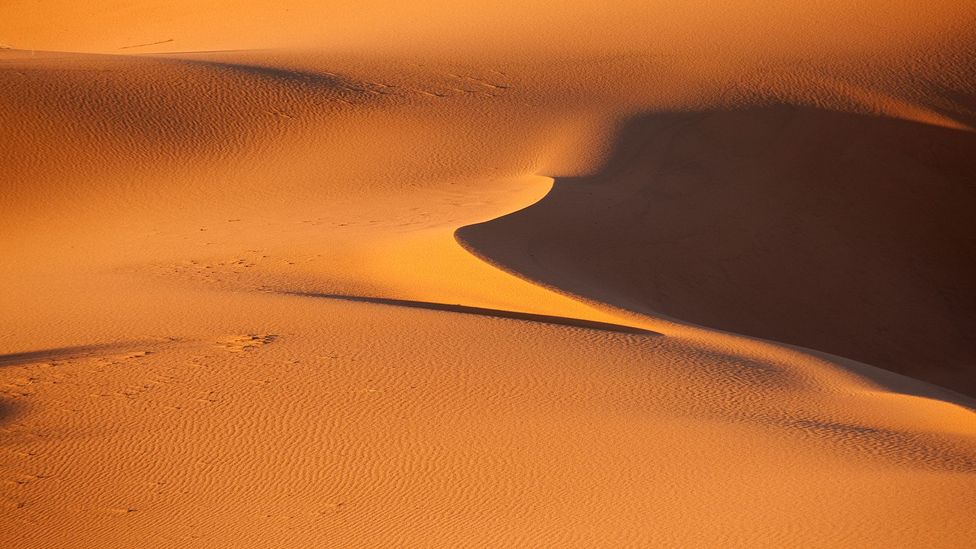
Smoothed by the wind, sand in deserts like the Sahara, which comprehend huge swathes of the planet, practice not lock together well in concrete (Credit: Alamy)
Creating buildings to business firm all those people, along with the roads to knit them together, requires biggy quantities of sand. In India, the amount of construction sand used annually has more than than tripled since 2000, and is even so rising fast. China lonely has probable used more sand this decade than the U.s. did in the entire 20th Century. In that location is so much need for certain types of construction sand that Dubai, which sits on the edge of an enormous desert, imports sand from Commonwealth of australia. That's right: exporters in Commonwealth of australia are literally selling sand to Arabs.
But sand isn't simply used for buildings and infrastructure – increasingly, it is also used to industry the very state below their feet. From California to Hong Kong, ever-larger and more powerful dredging ships vacuum up millions of tonnes of sand from the sea floor each year, piling it up in coastal areas to create state where there was none earlier. Dubai'due south palm-tree shaped islands are perhaps the nigh famous artificial land masses that have been built from scratch in recent years, but they have plenty of company.
Lagos, the largest city in Nigeria, is adding a 2,400-acre (9.7 sq km) urban extension to its Atlantic shoreline. China, the quaternary-largest nation on World in terms of naturally occurring land, has added hundreds of miles to its coast, and built entire islands to host luxury resorts.
This new real estate is valuable, only it frequently incurs steep costs. Ocean dredging has damaged coral reefs in Kenya, the Western farsi Gulf and Florida. It tears upward marine habitat and muddies waters with sand plumes that can touch aquatic life far from the original site. Fishermen in Malaysia and Kingdom of cambodia take seen their livelihoods decimated by dredging. In Cathay, land reclamation has wiped out coastal wetlands, annihilated habitats for fish and shorebirds, and increased water pollution.
And then at that place'due south Singapore, a globe leader in state reclamation. To create more space for its nearly vi one thousand thousand residents, the jam-packed metropolis-land has built out its territory with an additional fifty sq miles (130 sq km) of land over the past forty years, about all of information technology with sand imported from other countries. The collateral environmental damage has been so extreme that neighbouring Indonesia, Malaysia, Vietnam, and Kingdom of cambodia have all restricted exports of sand to Singapore.
All told, according to a Dutch research group, human beings since 1985 accept added v,237 sq miles (thirteen,563 sq km) of artificial land to the world's coasts – an area most as large as the nation of Jamaica. Most of information technology built with gargantuan amounts of sand.
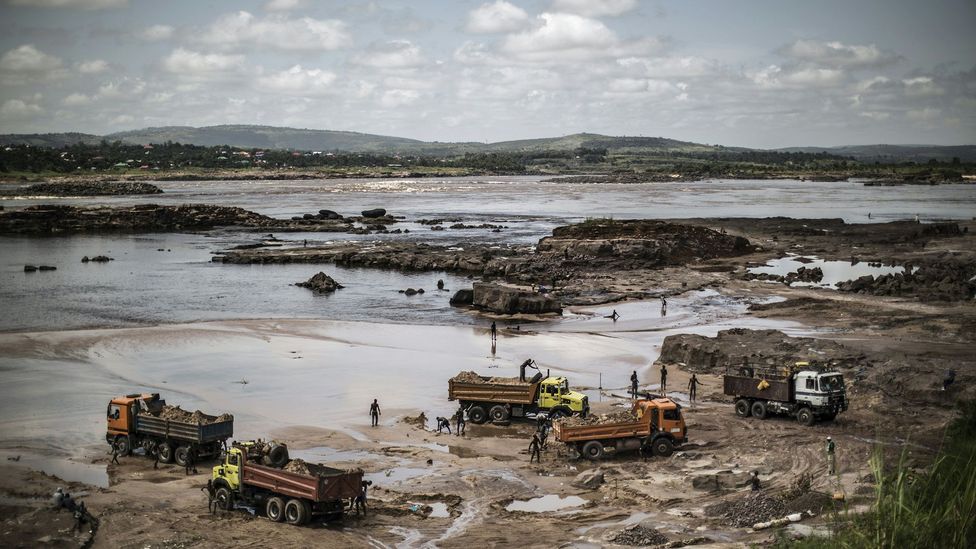
Sand is extracted on an industrial scale from rivers, lakes and beaches around the world to run across the global demand (Credit: Getty Images)
Mining sand to apply in concrete and other industrial purposes is, if anything, even more destructive. Sand for construction is near often mined from rivers. Information technology'southward easy to pull the grains up with suction pumps or even buckets, and piece of cake to ship once you've got a full boatload. Simply dredging a riverbed can destroy the habitat occupied past bottom-dwelling organisms. The churned-up sediment can deject the water, suffocating fish and blocking the sunlight that sustains underwater vegetation.
River sand mining is also contributing to the slow-motility disappearance of Vietnam'southward Mekong Delta. The area is home to 20 million people and source of half of all the country's food and much of the rice that feeds the balance of South Eastern asia. Climate-change-induced sea level rise is one reason the delta is losing the equivalent of ane and a one-half football fields of land every mean solar day. Just another, researchers believe, is that people are robbing the delta of its sand.
For centuries, the delta has been replenished by sediment carried down from the mountains of Fundamental Asia past the Mekong River. But in recent years, in each of the several countries along its course, miners have begun pulling huge quantities of sand from the riverbed. According to a 2013 study by three French researchers, some 50 1000000 tonnes of sand were extracted in 2011 alone – plenty to encompass the metropolis of Denver two inches deep. Meanwhile, v major dams have been congenital in recent years on the Mekong and some other 12 are slated for structure in China, Laos, and Cambodia. The dams further diminish the flow of sediment to the delta.
In other words, while natural erosion of the delta continues, its natural replenishment does not. Researchers with the Greater Mekong Plan at the Globe Broad Fund for Nature (WWF) believe that at this charge per unit, nearly half the delta will exist wiped out by the finish of this century.
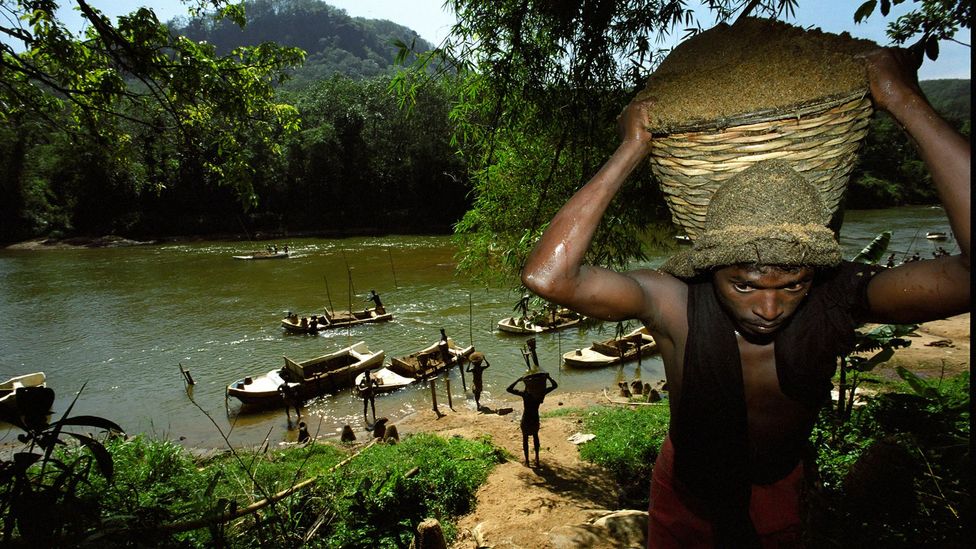
Extracting sand from quarries forth river banks in places similar Sri Lanka is dorsum-breaking work (Credit: Getty Images)
To make matters worse, dredging the Mekong and other waterways in Cambodia and Laos is causing river banks to collapse, dragging downward crop fields and even houses. Farmers in Myanmar say the same affair is happening along the Ayeyarwady River.
Sand extraction from rivers has also caused untold millions of dollars in impairment to infrastructure effectually the world. The stirred-upward sediment clogs h2o supply equipment. And removing all that material from river banks leaves the foundations of bridges exposed and unsupported. In Ghana, sand miners have dug upward so much ground that they have dangerously exposed the foundations of hillside buildings, which are at run a risk of collapse. That'south not simply a theoretical take chances. Sand mining caused a bridge to collapse in Taiwan in 2000, and another the following year in Portugal only as a motorbus was passing over it, killing 70 people.
Demand for high-purity silica sands, which are used to make drinking glass besides as high-tech products like solar panels and reckoner fries, is likewise soaring. America'south surging fracking industry as well needs the extra-durable high-purity grains. The effect: acres of farmlands and forests in rural Wisconsin, which happens to have a lot of those precious sands, are being torn up.
The contest for sand has grown so intense that in many places criminal gangs accept gotten into the trade, excavation grains up by the megatonne to sell on the black marketplace. In parts of Latin America and Africa, according to man rights groups, children are forced to work as virtual slaves in sand mines. The gangs get away with all this the same way organised crime does everywhere – by paying off corrupt police and government officials to leave them alone. And, when they deem it necessary, by assaulting and fifty-fifty killing those who get in their way.
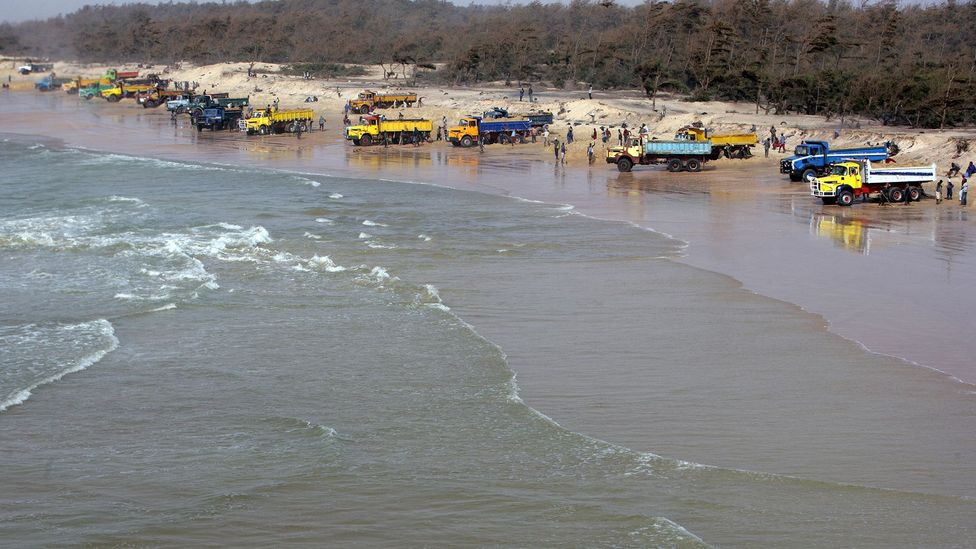
Criminal gangs take found that illegally extracting sand from beaches or quarries and selling it on the blackness market is a lucrative business (Credit: Getty Images)
José Luis Álvarez Flores, an environmental activist in the southern Mexican state of Chiapas who campaigned against illegal sand mining in a local river, was shot dead in June. A note threatening his family unit and other activists was reportedly found with his body. Two months after, police in Rajasthan, India, were shot at when they tried to stop a convoy of tractors carrying illegally mined sand. The ensuing gun boxing left two miners dead and 2 police officers hospitalised. And early this year, a sand miner in Southward Africa was shot vii times in a dispute with some other group of miners.
Those are only the latest casualties. Violence over the sand trade in recent years has taken lives in Republic of kenya, Republic of the gambia, and Indonesia. In Bharat, "sand mafias", equally the local press calls them, have injured hundreds and killed dozens of people. The victims include an 81-yr-one-time teacher and a 22-year-old activist who were separately hacked to death, a announcer burned to expiry, and at least iii police officers run over by sand trucks.
Sensation of the damage caused past our addiction to sand is growing. A number of scientists are working on means to supersede sand in physical with other materials, including wing ash, the material left over by coal-fired power stations; shredded plastic; and even crushed oil palm shells and rice husks. Others are developing physical that requires less sand, while researchers are also looking at more effective means to grind downwards and recycle concrete.
In many Western countries, river sand mining has already been largely phased out. Getting the rest of the earth to follow conform will exist tough, though. "Preventing or reducing likely damage to rivers will require the construction industry to exist weaned off river sourced aggregate," says a contempo report on the global sand industry by WWF. "This type of societal shift is similar to that required to address climate change, and volition necessitate changes in the way that sand and river are perceived, and cities are designed and constructed."

Sand-covered beaches are frequently depicted equally paradise, but in some parts of the earth they are beingness dug up and sold by the tonne (Credit: Alamy)
Mette Bendixen, a coastal geographer at the University of Colorado, is one of a growing number of academics calling for the United nations and the World Trade Organisation, to do more to limit the damage caused by sand mining. "Nosotros should have a monitoring program," says Bendixen. "More direction is needed because correct at present it'due south not beingness managed at all."
At present, no one even knows exactly how much sand is existence pulled out of the earth, nor where, nor under what atmospheric condition. Much of it is undocumented. "We simply know," says Bendixen, "that the more people in that location are, the more sand nosotros need."
* Vince Beiser (@VinceBeiser ) is the author of "The World in a Grain: The Story of Sand and How It Transformed Civilization".
Source: https://www.bbc.com/future/article/20191108-why-the-world-is-running-out-of-sand
0 Response to "what to do with a lot of sand"
Enregistrer un commentaire